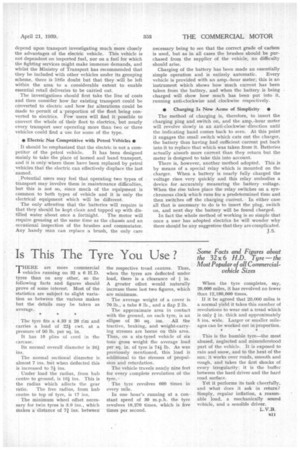Is This The Tyre You Use ?
Page 47

If you've noticed an error in this article please click here to report it so we can fix it.
THERE are more commercial vehicles running on 32 x 6 M.D. tyres than on any other, so the following facts and figures should prove of some interest. Most of the statistics are subject to slight variation as between the various makes but the details may be taken as average.
The tyre fits a 4.33 X 20 rim and carries a load of 221 cwt. at a pressure of 90 lb. per sq. in.
It has 10 plies of cord in the carcase.
Its normal overall diameter is 341 ins.
The normal sectional diameter is almost 7 ins, but when deflected this is increased to 7-i ins.
Under load. the radius, from hub centre to ground, is 161 ins. This is the radius which affects the gear ratio. The free radius, from hub centre to top of tyre, is 17 ins, The minimum wheel offset necessary for twin tyres is 3.9 ins., which Makes a distance of 7/ ins, between the respective tread centres. Thus, when the tyres are deflected under load, there is a clearance of in. A greater offset would naturally increase these last two figures, which are minimum.
The average weight of a cover is 70 lb., a tube 8 lb., and a flap 2 lb.
The approximate area in contact with the ground, on each tyre, is an ellipse of 30 sq. ins. All the tractive, braking, and weight-carrying stresses are borne on this area. Thus, on a six-tyred vehicle of six tons gross weight the average load per sq. in. of tyre is 74-hlb. As was previously mentioned, this load is additional to the stresses of propulsion and retardation.
The vehicle travels nearly nine feet for every complete revolution of the tyre.
The tyre revolves 609 times in every mile.
In one hour's running at a constant speed of 30 m.p.h. the tyre revolves 18,270 times, which is five times per second. When the tyre completes, say, 20,000 miles, it has revolved no fewer than 12,180,000 times.
If it be agreed that 20,000 miles is a normal yield it takes this number of revolutions to wear out a tread which is only / in. thick and approximately 5 ins. wide. Larger or smaller mileages can be worked out in proportion.
This is the humble tyre—the most abused, neglected and misunderstood part of the vehicle. It is exposed to rain and snow, and to the heat of the sun; it works over roads, smooth and rough, and takes the first shocks of every irregularity; it is the buffer between the hard driver and the hard road surface.
Yet it performs its task cheerfully, and what does it ask in return? Simply, regular inflation, a reasonable load, a mechanically sound vehicle, and a sensible driver.






































































































































